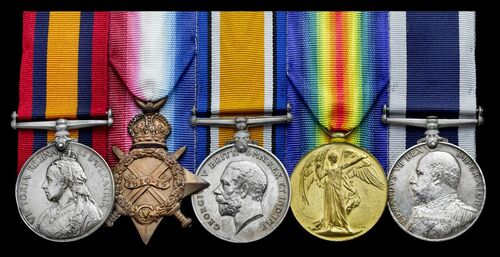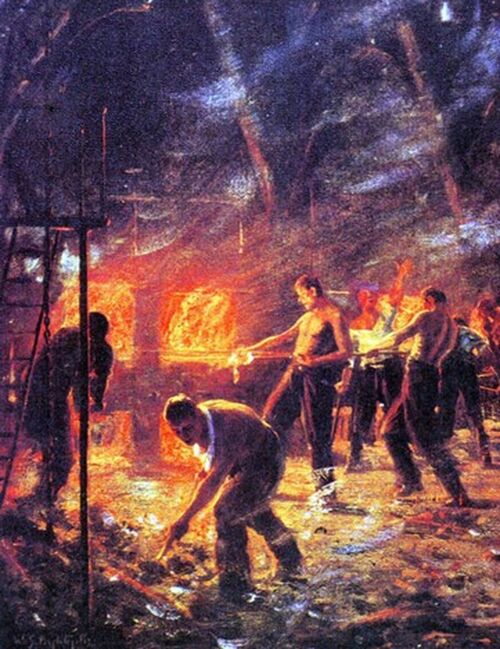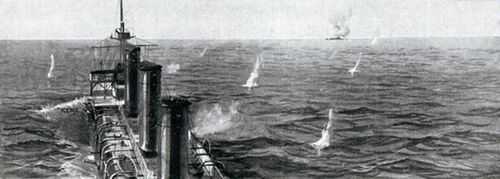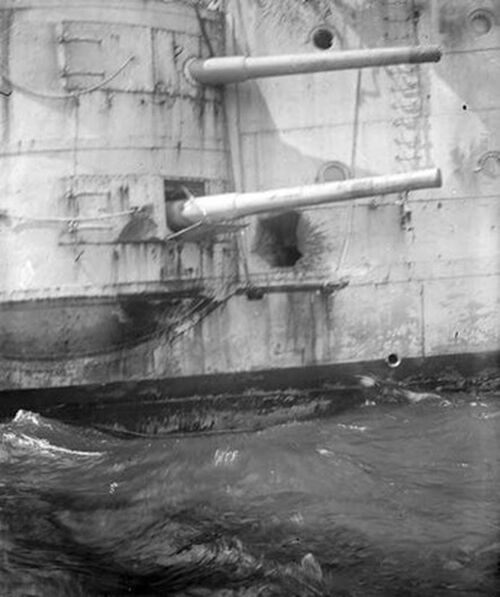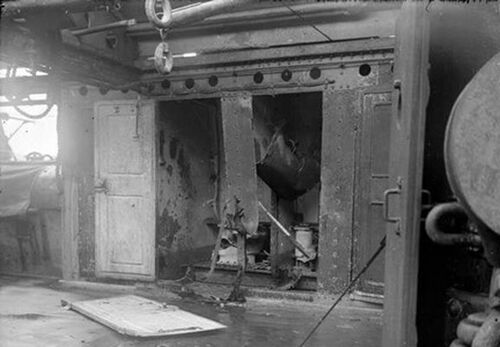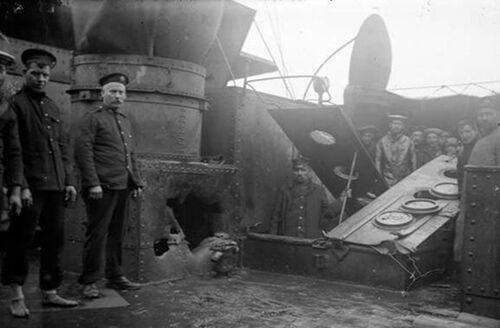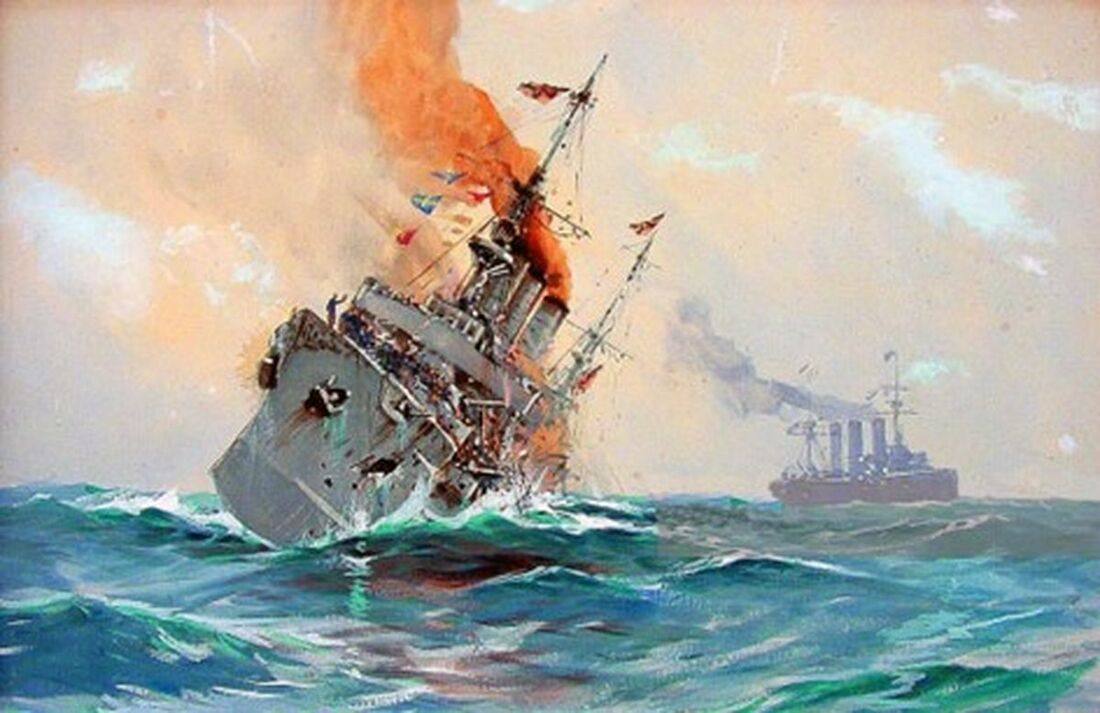Auction: 24002 - Orders, Decorations and Medals
Lot: 103
'All our people were wonderfully cool and not a soul seemed to have the slightest doubt about the result. We had been using a good deal of Lyddite and so had they. Our hammock nettings were quite yellow from Lyddite which had exploded from their shells. The fore turret landed her a lovely smack just by the quarterdeck and by 6.26 she was now undoubtedly done for. Then she just began to haul down her ensign but it was hauled up again and she opened fire at us.
The range was now about 3,000 yards and when we replied her decks became an absolute shambles, and one shell alone killed 50 men. We absolutely could not miss her and pumped in shot after shot. Then she was seen to list heavily to starboard and dipped her ensign, at 6.57. They were blazing and had every gun silenced. The list was now steadily becoming worse and worse till about 7.27 p.m., when she capsized and then half righted herself only to go over again. Some of her crew took to the water before this. Then her bows came up in the air and she went under for good. We had ceased fire at 6.57." Nürnberg's finishing-off of Kent's sister ship the Monmouth at Coronel had been avenged.'
An extract from Midshipman Burridge's account of H.M.S. Kent at the battle of the Falklands, refers.
A Boer War and Great War campaign group of five awarded to Petty Officer 1st Class C. Yarram, Royal Fleet Reserve, late Royal Navy, who was present in the cruiser H.M.S. Kent at Vice-Admiral Sir Frederick Sturdee's celebrated victory off the Falklands on 8 December 1914
Having filled her furnaces with anything combustible to increase her speed - including it is said her lifeboats - Kent caught up with the enemy cruiser Nürnberg and closed the range to around 3,000 yards. She then raked her adversary's decks with a spate of devastating broadsides, reducing her to a blazing inferno from stem to stern
Kent, too, was badly damaged, sustaining 40 hits and resultant casualties, but she was able to make her way back to Port Stanley unaided
For the full story of Kent's remarkable part in the battle, see Surgeon T. B. Dixon's The Enemy Fought Splendidly, and:
https://www.canterbury-cathedral.org/wp-content/uploads/2014/10/HMS-KENT-Web-Quality-v2.pdf
Queen's South Africa 1899-1902, no clasp (C. Yarram, P.O. 1 Cl., H.M.S. Gibraltar); 1914-15 Star (138741 C. Yarram, P.O. 1, R.N.); British War and Victory Medals (138741 C. Yarram, P.O. 1, R.N.); Royal Navy L.S. & G.C., E.VII.R. (Chas. Yarram, P.O. 1 Cl., H.M.S. Gibraltar), minor edge bruising, generally very fine (5)
Charles Yarram was born in Southampton, Hampshire on 4 September 1870 and entered the Royal Navy as a Boy 2nd Class in September 1886. Having then been awarded his L.S. & G.C. Medal in March 1904, he came ashore as a Petty Officer 1st Class in October 1910 and enrolled in the Royal Fleet Reserve.
Recalled on the outbreak of hostilities, he joined the armoured cruiser H.M.S. Kent in October 1914 and remained likewise employed until January 1917. He was consequently present at Vice-Admiral Sir Frederick Sturdee's celebrated victory off the Falklands on 8 December 1914.
Battle of the Falklands
It was at 4.30 p.m. on 8 December 1914 that Kent began her pursuit of S.M.S. Nürnberg, when she was positioned seven miles behind her adversary. Kent's nominal maximum speed was 22 knots, but she was a notoriously bad steamer. Nürnberg, meanwhile, was expected to achieve a slightly better speed but, in the event, she put so much strain on her boilers - which were in need of a complete overhaul after months at sea - that two burst, reducing her speed to 19 knots.
Kent had not been afforded the opportunity of taking on coal at Port Stanley before the action began so that she was very short of fuel. In consequence, Captain J. D. Allen, C.B., R.N., ordered that every item of wood be taken to the engine-room for the stokers to load into the burners. Woodwork was stripped from all the fittings and even the officers' trunks were burnt; some accounts state that even the ship's lifeboats were broken up for like purposes. Either way, Kent appears to have reached a speed of 25 knots, thereby allowing her to close her adversary.
By 5 p.m. Kent was within 12,000 yards of Nürnberg. The latter opened fire with her rear 4.1-inch guns, her shots falling close around Kent, but achieving only one hit. Kent replied with her forward 6-inch gun, but the range was still too great.
By 5.45 p.m. Kent had sufficiently closed the gap for Nürnberg to turn to port and fire a broadside. But Captain Allen of the Kent was not interested in a long-range duel, the vibration caused by her speed making range finding almost impossible. Moreover, the light was beginning to fail.
He therefore turned Kent six points to port onto a converging course and the range quickly fell to 6,000 yards. It was at this point that Kent's gunnery became more effective and, by 6 p.m., the range was down to about 3,000 yards. Nürnberg turned away to starboard but Kent's heavier guns continued to make an impact.
By 6.10 p.m. Nürnberg was losing speed, ablaze and with only two guns operational. In consequence, Kent was able to pass her, turn to starboard and to cross in front of her. In response, Nürnberg turned to port, thereby allowing Kent the opportunity - as she crossed Nürnberg's bow - to rake her with her starboard batteries. Given the short range, the consequences were devastating. Two 6-inch shells destroyed Nürnberg's forward turret and Kent then turned away, enabling her port batteries to open fire.
By 6.25 p.m. Nürnberg was stationary and silent. Listing heavily and down at the stern, she was burning fiercely under her bridge and there were no signs of life. Kent ceased firing and closed her, from which distance her adversary's battle ensign was seen to be flying. Captain Allen therefore resumed Kent's fire until, five minutes later, Nürnberg's ensign was finally hauled down.
Kent's remaining lifeboats had been damaged in the action, but two were repaired sufficiently to be launched. Soon after, at around 7.30 p.m., Nürnberg turned over to starboard and sank. A search for survivors was maintained until 9 p.m., by which time it was dark. Just seven members of Nürnberg's crew were picked up alive.
For her own part, Kent had been hit forty times, and suffered a loss of four killed and 12 wounded. One shell wrecked her radio room and another round burst outside a midships' casemate, igniting several bags of cordite. Thanks to the gallant actions of Sergeant Charles Mayes of the Royal Marine Artillery - who closed the door to the magazine and hosed down the cordite - a potential catastrophe was averted. He was awarded the Conspicuous Gallantry Medal.
S.M.S. "Dresden" - icing on the cake
As stated, Yarram remained aboard Kent until January 1917, and he was back in action in March 1915, when the Dresden - which had escaped Sturdee's squadron off the Falklands in 1914 - was spotted moving up the Chilean coast. Having evaded Kent's guns on account of her superior speed, one of Dresden's wireless transmissions was intercepted, in which it was revealed she intended to rendezvous with her colliers off Robinson Crusoe Island in the Juan Fernandez Islands.
What followed mirrored the fate of the Graf Spee's in the River Plate action in December 1939, for Dresden became trapped in neutral waters by the subsequent arrival of Kent and her consort, Glasgow. International law permitted Dresden's captain 24 hours grace, but he obtained an extension of a week, claiming disabled engines. Foolishly, however, when Kent and Glasgow hove into view of the 14 March, he trained Dresden's guns on them. The British response was swift, the Dresden being holed and set on fire by gunfire within a matter of minutes.
The Germans quickly hoisted a white flag and sent an officer in a boat to Glasgow, to complain that the Dresden was under Chilean protection. But the British were having none of it, Glasgow's captain claiming Dresden's actions to be in violation of Chilean neutrality and of an unfriendly nature for an interned ship: unless the Germans formally surrendered and engaged a diplomatic solution, Dresden would be sunk.
The Germans chose to scuttle her and, by way of revenge, mounted their infamous attack on Hartlepool, Scarborough and Whitby one week later.
Subsequent career
Prior to departing Kent in January 1917, Yarram participated in assorted convoys and, in April 1916, an unsuccessful attempt to locate Shackleton's missing Antarctic Expedition.
He ended the war with an appointment at the shore establishment Dolphin and was demobilised in February 1919.
Subject to 20% VAT on Buyer’s Premium. For more information please view Terms and Conditions for Buyers.
Sold for
£450
Starting price
£240

